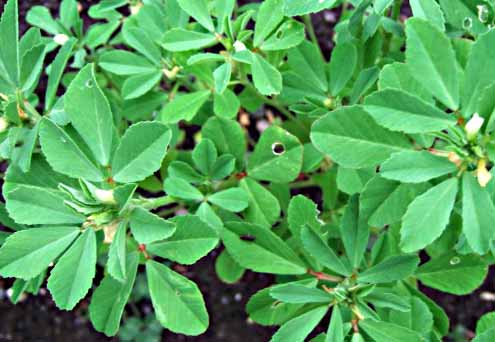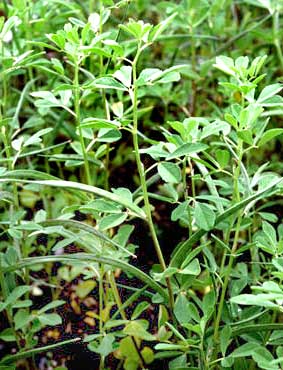An very aromatic plant for full sun on a well drained soil. The long thin pods make an interesting conversation piece. Needs rich soil and regular watering to perform at its best and produce great seeds.
Description.
An annual in the pea family Fenugreek looks rather like a vetch. It is an erect plant growing from 1-2 feet tall (50 cm). It has long slender stems with three lobed (tripartite) toothed gray green obovate leaves, 3/4-1 in (20-25 mm) long. These are arranged opposite on the stem attached by short stalks. The flowers are borne singly or in pairs at the top leaf axils of the stems and are white or pale yellow in color and look exactly like pea or clover-like flowers. The flowers are followed by thin, sword-shaped pods are 4-6 in (10-15 cm), with a curved beak-like tip, each carrying 10-20 seeds. The whole plant is aromatic.
Location and Care.
Fenugreek needs full sun and well drained soil that can be neutral to slightly acid. Unlike many herbs Fenugreek does best in rich fertile soil so it needs a lot of compost and/or organic material. The soil must be well drained it cannot tolerate wet feet for any period of time, but needs regular watering, a soaker hose once a day or every two days is ideal. It likes hot weather and grows rapidly when the temperatures are high but slowly in cooler ones. Hot summers are needed to grow this successfully it takes approx 120 - 150 days from planting to harvest. Fenugreek is one of those vetch plants that has a symbiotic relationship with certain soil bacteria. These bacteria form nodules on the roots of the plant and have the ability to fix nitrogen from the air. This is then used by any nearby plants to help with growth. When cleaning up the plants in the fall, leave the roots in the ground to ensure the most benefit from the nitrogen for the next season or crop.
Growing.
Fenugreek does not like to be transplanted. For this reason its best to sow the seeds directly into the soil. Plant shallow - less than a quarter inch when all danger of frost has passed and the soil temperature is at least 65ºF. At this temperature the seeds should germinate in 7-10 days. Thin plants to 4-5 inches apart.
If starting indoors sow seeds in individual biodegradable pots (such as peat) that can be placed directly into the ground to prevent root disturbance. Harden off seedlings well before planting outside in full sun to avoid sunburn or scorch. See General Growing Instructions.
Harvesting
Leaves can be harvested once the plant has reached 8 inches in height. Pick individual leaves or leaf tops to encourage branching. Do not harvest leaf tops once flowers have begun or no seed will be produced.
Seed pods can be harvested as they dry or wait until the whole plant has dried and cut down all at once. This method is not recommended if seed pods are ripening at different rates as some seeds may be lost from earlier ripening pods. Ripening will depend on your location and the amount of sun and heat the plant obtained. Pods can then be thrashed and the seeds removed using a sieve. Winnowing can be used but care must be taken as seeds can blow away also. Store seeds in airtight containers in a cool, dry, dark location.
Culinary Use.
Fresh leaves can be used in salads or eaten as a vegetable. A soothing tea can also be made from the leaves. Sprouted seeds can also be used in salads or as a vegetable and add a spicy flavor.
The seeds have a strong spicy flavor. In most case they are lightly roasted before use as this improves the flavor greatly. Most commonly they are dry roasted in a skillet, over roasting turns the seed red and bitter. Correctly done they have a flavor that is spicy sweet, similar to burnt sugar. This turns much more flavorful when cooked. When ground the roasted seeds are the principle ingredient in many curries
and in mango chutney. It is also used for a large number of spice mixes, pickles and as flavoring in some breads. Used subtly they can produce a maple syrup like flavor in some foods. Roasted the seeds are used to make a coffee substitute.
An essential oil made from the seeds is used as a food flavoring in imitation maple syrup, vanilla compositions, licorice and pickles
Medicinal uses.
Used extensively in North Africa, the Middle East and India Fenugreek has a wide range of uses. The seeds are very nourishing and are often used to help gain weight in patients with anorexia nervosa. Effective in body building they are used in tonics especially for cases of physical debility caused by anemia or by infectious diseases, and for nervous disorders.
The list of uses is long including many digestive ailments from poor digestion, ulcers in the stomach and intestines , late-onset diabetes, painful menstruation and labor pains, poor circulation, tinnitus and cleaning the sweat glands. Research has also suggested fenugreek is a cancer inhibitor, can lower blood cholesterol levels and has an antidiabetic effect.
Chewed the seeds can freshen bad breath and restore a dulled sense of taste.
Externally ground seeds are used in a poultice for abscesses, boils, ulcers, burns etc, or they can be used as a douche for excessive vaginal discharge.
The seeds should not be used medicinally for pregnant women since they can induce uterine contractions
Other Names
Bird's Foot, Foenugreek, Goat's Horn, Bockshornklee, Greek Hayseed,








